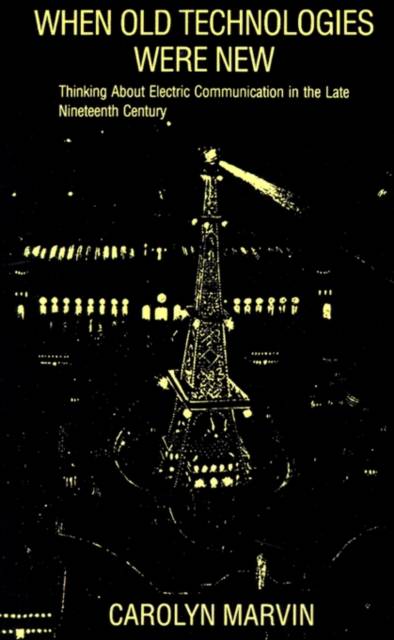
- Afhalen na 1 uur in een winkel met voorraad
- Gratis thuislevering in België vanaf € 30
- Ruim aanbod met 7 miljoen producten
- Afhalen na 1 uur in een winkel met voorraad
- Gratis thuislevering in België vanaf € 30
- Ruim aanbod met 7 miljoen producten
Zoeken
When Old Technologies Were New
Thinking about Electric Communication in the Late Nineteenth Century
Carolyn Marvin
Paperback | Engels
€ 91,95
+ 183 punten
Omschrijving
In the history of electronic communication, the last quarter of the nineteenth century holds a special place, for it was during this period that the telephone, phonograph, electric light, wireless, and cinema were all invented. In When old Technologies Were New, Carolyn Marvin explores how two of these new inventions--the telephone and the electric light--were publicly envisioned at the end of the nineteenth century, as seen in specialized engineering journals and popular media. Marvin pays particular attention to the telephone, describing how it disrupted established social relations, unsettling customary ways of dividing the private person and family from the more public setting of the community. On the lighter side, she describes how people spoke louder when calling long distance, and how they worried about catching contagious diseases over the phone. A particularly powerful chapter deals with telephonic precursors of radio broadcasting--the "Telephone Herald" in New York and the "Telefon Hirmondo" of Hungary--and the conflict between the technological development of broadcasting and the attempt to impose a homogenous, ethnocentric variant of Anglo-Saxon culture on the public. While focusing on the way professionals in the electronics field tried to control the new media, Marvin also illuminates the broader social impact, presenting a wide-ranging, informative, and entertaining account of the early years of electronic media.
Specificaties
Betrokkenen
- Auteur(s):
- Uitgeverij:
Inhoud
- Aantal bladzijden:
- 296
- Taal:
- Engels
Eigenschappen
- Productcode (EAN):
- 9780195063417
- Verschijningsdatum:
- 24/05/1990
- Uitvoering:
- Paperback
- Formaat:
- Trade paperback (VS)
- Afmetingen:
- 213 mm x 140 mm
- Gewicht:
- 385 g

Alleen bij Standaard Boekhandel
+ 183 punten op je klantenkaart van Standaard Boekhandel
Beoordelingen
We publiceren alleen reviews die voldoen aan de voorwaarden voor reviews. Bekijk onze voorwaarden voor reviews.








